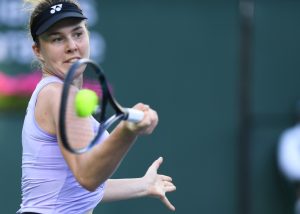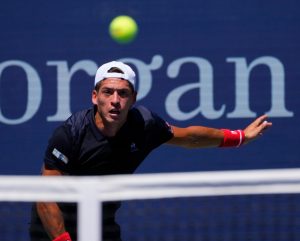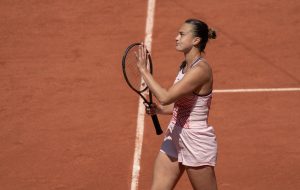Famously, the members of Monty Python struggled to name famous Belgians. Until recently, if they had tried to name famous Belgian tennis players, they would have found the task even harder. Since the turn of the millennium, however, Belgian tennis has experienced something of a golden age, particularly on the women’s side, as Justine Henin and Kim Clijsters not only won individual Majors but collectively led Belgium to a Fed Cup win. Now it is the turn of the Belgian men, as they prepare for their second Davis Cup final in three seasons, and with David Goffin showing at the ATP Finals that he is now undoubtedly one of the best players in the world, they have a real chance of finally winning the greatest team competition in tennis.
Belgium was actually one of the first tennis nations. In 1904, along with France, they became the first country outside of Britain and America to enter the Davis Cup, and they did well on their debut, reaching the final after defeating their fellow newcomers. That earned them the right to face the holders, Britain, after America had failed to send a team. However, at a time when Anglophone tennis–Britain, America, and Australia-was undoubtedly the strongest in the world, the Belgians were beaten 5-0 and it would be more than a century before they would reach the Davis Cup Final again.
It was not until the early 21st century that Belgian tennis finally stirred again, and initially that was on the women’s side. Justine Henin and Kim Clijsters emerged almost simultaneously in 2001, with both women reaching Grand Slam finals that year. First, Clijsters lost one of the greatest ever French Open Finals to a resurgent Jennifer Capriati. Then, Henin reached the Wimbledon final but lost to Venus Williams, when Venus was probably at her imperious best, as shown by her “bageling” of Henin in the decisive third set.
However, Henin and Clijsters soon proved that they had learned the lessons from those Grand Slam final defeats as they led Belgium to the final of the 2001 Fed Cup against Russia. On neutral territory in Spain, but crucially on the clay that both women were most comfortable on, Henin and Clijsters defeated Nadia Petrova and Elena Dementieva respectively, with both women winning the first set of their matches to love and then closing out the match in straight sets. Thus they rendered the doubles contest (which the Belgian pair of Els Callens and Laurence Courtois lost in straight sets) a dead rubber.
Belgium returned to the Fed Cup Final in 2006, but Henin did not play in that final as she was injured ,and the Henin-less Belgium succumbed to Italy, even though that final was actually played in Belgium–although, surprisingly, not on clay. Otherwise, Henin and Clijsters, like most top female and male singles players in recent decades, did not play regularly in the Fed Cup and concentrated on winning individual Slams. Since their retirement, the most accomplished female Belgian player has been Kirsten Flipkens, although she is not remotely in the class of Henin or Clijsters. Her greatest feat was reaching the Wimbledon semifinal in 2013, where she lost meekly to the eventual champion, Marion Bartoli of France, 6-1, 6-2.
On the men’s side, it took even longer to produce great Belgian players. Prior to David Goffin and Steve Darcis, the most famous Belgian male tennis players were probably the Rochus Brothers, Olivier and Christophe, and Xavier Malisse, who reached the Wimbledon singles semifinal in 2002. Malisse lost in five sets to David Nalbandian and never got close to that kind of achievement again in his career.
It was with the emergence of Darcis and particularly Goffin that Belgium suddenly had a men’s team to compete with the best in tennis. First, they reached the 2015 Davis Cup Final, where they lost to an Andy Murray-inspired Great Britain team. (Some would have said that Murray was the British team that year, given that in the final he played two singles matches and the doubles match, winning each one.) Now, two years on, Belgium is in the final again and, even if the tie is on French soil, they have a realistic chance of defeating their hosts.
Goffin, of course, is fresh from his superb performance at the ATP Finals, where he became one of the few players to beat both Rafael Nadal and Roger Federer in the same tournament before losing in the final to Grigor Dimitrov. He will hope that that loss was only a precursor to winning an even greater prize, namely the Davis Cup.
Goffin will start as favourite in his singles matches in the Final, which will probably be against Lucas Pouille and Jo-Wilfried Tsonga. If he can win both his matches, Belgium will only need one more point to win the tie. They will obviously hope that Darcis can win one of his two singles matches, but if Goffin and Darcis were both to win their matches on the first day, the Belgian captain, Johan Van Herck, might be sorely tempted to team them up in the doubles. Otherwise, Belgium’s probable pairing of Rubens Bemelmans and Arthur de Greef will struggle to compete with the superb French pairing of Pierre-Hugues Herbert and Nicolas Mahut, who are among the top doubles pairings in the world, as demonstrated by their presence in the doubles at the ATP Finals last week.
Whatever happens this weekend, though, Belgian tennis has come a long way in the past century and particularly in the past twenty years. With Goffin primed to be one of the main contenders when the post-Rafa and Roger era in men’s tennis finally begins (whenever that may be), Belgian tennis, especially Belgian men’s tennis, is likely to be strong in the coming years. As a result, in the future even Monty Python fans might be able to name at least one Belgian tennis player.
Main Photo:
Embed from Getty Images






